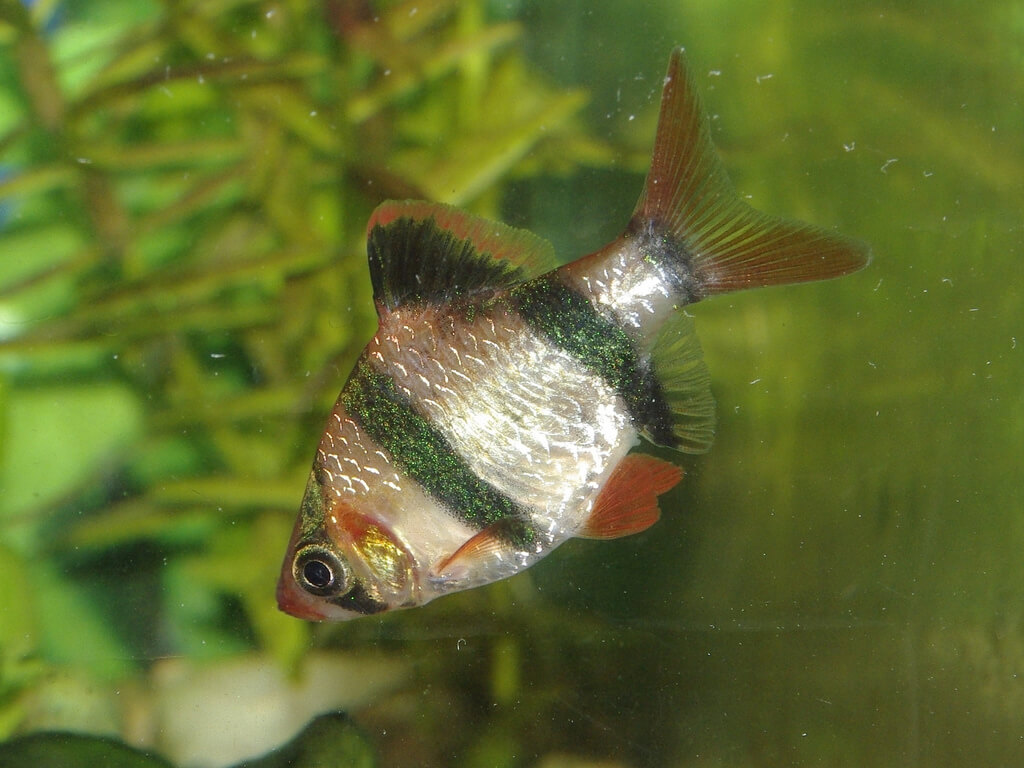Tiger Barb Care Sheet

The Sumatra barb, more popularly known as the tiger barb, is a tropical fish that is immensely popular amongst hobbyists. In this comprehensive care sheet we’ll discuss everything you need to know to successfully keep your tiger barbs happy and healthy.
Habitat

While the tiger barb is native to Asia and Africa, where it is usually found in streams and rivers, this fish can survive well in aquariums.
There are a number of factors to be taken into consideration here. This includes the size of the tank that the fish will be living in, the temperature of water, its composition, the plant content and other aquarium equipment.
Let’s tackle all of these individually.
Tank Size
Tiger barbs are about 3-4 inches long and between 1-1.5 inches wide at adulthood. This means they aren’t particularly large and you may think that a small tank is enough to keep them happy. Think again.
Tiger barbs are very active. This means they will be zipping from one end of the aquarium to the other. While smaller 10 or 20 gallon tanks work for cherry barbs and gold barbs, the slighter bigger species like tiger barbs, black ruby barbs and others need bigger aquariums – at least 30 gallons.
In addition to this, tiger barbs are sociable fish that like to interact with each other.
For this reason, it is important that you have at least six tiger barbs (if you can accommodate more, it’s even better) in your tank at any given time. They should have enough space to swim around. This also prevents the tiger barbs from attacking other species.
Water Temperature
As tiger barbs are tropical fish, they need the temperature to remain between 75° F and 80° F (between about 24° C and 27° C).
Water Composition
There are some things to keep in mind when you are trying to set the ideal conditions for tiger barbs to survive.
The traditional composition of the water in which tiger barbs are found naturally is soft and a little acidic. As a rule of thumb, keep the pH level of your aquarium between 6 and 7.8. The ideal alkalinity level should be between 50 ppm and 140 ppm.
In addition to this, you need to install a good filtration system and focus on changing anywhere between 10% and 25% of the tank’s water every other week.
Equipment and Plants
When it comes to equipment, the first thing that comes to mind is a filtration system. If you want any fish to survive, you will have to invest in a high quality filtration system.
The lighting inside the tank should be of good quality and the base should be filled with fine substrate (where plants can root themselves).
Lastly, remember to have a lid on top of the aquarium so that tiger barbs don’t jump out from the open space.
Behavior of Tiger Barbs
Tiger barbs are very active fish. They are constantly on the go, swimming from one side of the aquarium to the other.
However, they aren’t the best choice of fish when it comes to community tanks. The main reason behind this is that tiger barbs communicate with each other by nipping. This is why they are put in the “semi-aggressive” temperament category.
While it isn’t really a problem for other fish that are just as active and fast as them, it can terrorize other types of fish that are slower or have long, flowing fins – even if they are larger in size than the tiger barb.
This is also the reason why at least half a dozen of these fish are kept together. When there are a decent number of tiger barbs in the tank, they will keep engaging with each other and not harm the other types of fish in the aquarium.
Integration into the Tank
As tiger barbs are quite high on the hardiness scale, they do not take much time to adapt to different surroundings.
If you have set the temperature and composition of your tank’s water according to the parameters mentioned earlier, these fish will not take much time to adapt. However, if you want to be safe and not expose your other fish to any infection, you may want to quarantine the tiger barbs for a short while before they are introduced into the water tank.
During this period, you can watch out for any signs that indicate that the tiger barbs are not in the best possible health. Quarantining is especially important if you are interested in breeding, but more on that later!
Best Tank Mates


There are a couple of factors that need to be considered when picking tank mates for tiger barbs.
Firstly, they shouldn’t have long fins for the tiger barb to come and nip at.
Secondly, the fish should be fast enough to swim around the tank at a speed that can be compared to the tiger barb.
The third factor, which is just as important, is that you shouldn’t put very small fish in the same tank as the tiger barb is an omnivore that will eat things that are smaller than it.
Tiger barbs work best with tank mates that move quickly. Some examples are:
- Danios
- Platys
- Clown Loaches
- Catfish
- Serpae tetra
- Red eye tetra
- Black skirt tetras
- Red tail and rainbow sharks
- Other barb species
Fish That Don’t Work Well with Tiger Barbs


As has been mentioned before, any slow moving fish cannot survive in a tank with tiger barbs – regardless of the fish’s size. Even if the fish is quite large, the tiger barb will keep trying to nip at its fins, which can turn into an uncomfortable situation and some injuries.
Along the same lines, the fish that is kept with tiger barbs should not have very large fins. Some examples of fish that you should avoid keeping in the same tank as tiger barbs are mentioned below:
- Angelfish
- Bettas
- Gouramis
- Goldfish
- Neon tetras
- Guppies
Feeding
Tiger barbs love their food and they aren’t picky about it. They are omnivorous by nature, which means that they can source their nutrition from both plants and animals.
A good staple is a vegetable-based fish food. An example of this would be Omega One Veggie Rounds.
You could also feed them good quality flake food, for example tropical fish flakes.
The most attractive feature of tiger barbs is their colorful body and you should ensure that they are fed food that supports vibrancy.
You will also have to take their protein needs in mind. To fulfill this, you can feed them frozen or live food like brine shrimp, daphnia, beef heart and bloodworms from time to time. Not only can tiger barbs eat cooked vegetables, they can also consume many different types of small aquatic invertebrates with great ease.
Finally, it is important that you add variety to their nutrient intake so that they can live a healthier and longer life.
Breeding
While the male tiger barbs are brighter to look at, females are bigger in size. An interesting way to distinguish between them is that the males can be spotted with a red nose during the spawning period.
If you are interested in breeding tiger barbs, the process is a little complicated but still simpler than many other species of fish.
First, you will have to set up a separate breeding tank where you can place about 6 or so tiger barbs. Give them some time to make pairs and you will have a breeding pair soon enough.
This pair will have to be moved into another breeding tank that has some plants, soft water and a bare bottom. It is important to observe this tank continuously as tiger barbs consume their own eggs if given a chance. As soon as you spot the eggs and the male fertilizes them, move the adult fish out of the tank.
The eggs hatch over the next two days, after which point the fry should be allowed to swim around in that tank for another 5 days. During this period, feed them some brine shrimp and switch to flake food at a later stage.
Common Health Problems
The cleanliness and maintenance of the aquarium is of utmost importance if you are looking to prevent any health issues to your fish. Tiger barbs do not specifically suffer from any particular disease but there are some common diseases that afflict a number of aquarium fish.
The most common of these, which are also commonly noticed in tiger barbs, are mentioned below.
- Cottonmouth (columnaris): This is a bacterial infection that is very common in tiger barbs, which can be prevented simply by carrying out maintenance regularly. Fish suffering from cottonmouth develop white-looking lesions on their head or around their fins. It can be treated using antibiotics or by adding specific chemicals to the water.
- Ich (ichthyophthirius multifiliis): Ich or the white spot disease is very common amongst freshwater fish that are kept in aquariums. Once infected, the fish usually develop small lesions on the body, which look like blisters or white spots. Ich can be treated using aquarium salt but there is a very specific technique that needs to be followed.
Final Thoughts
Tiger barbs are beautiful creatures if you are looking to brighten up your aquarium. They are great to look at and easy to maintain because of their minimalistic needs.
This doesn’t, however, mean that they can just be thrown into your aquarium without any preparation. Keeping their temperament in mind, you will have to choose the right kind of tank mates for them. This means not just any fish can be added to an aquarium where tiger barbs are being kept.
Other than this, they are not picky eaters, they don’t need many special conditions and they are quite playful when you are looking at them from outside the aquarium.
Photos c/o snautsego, Allie_Caulfield & Frank Boston

